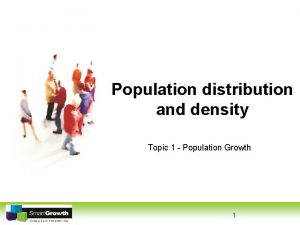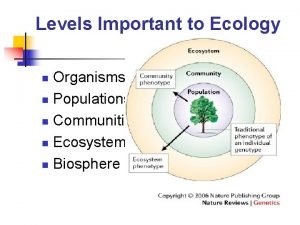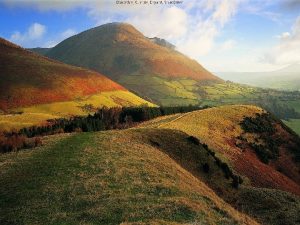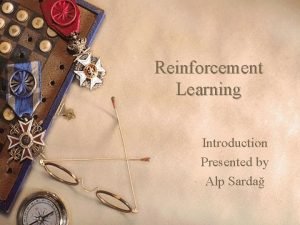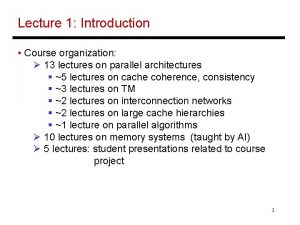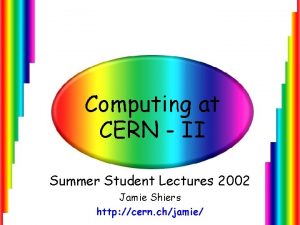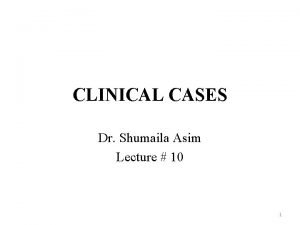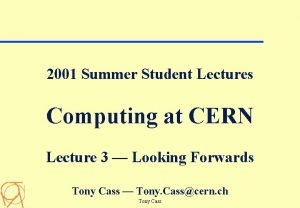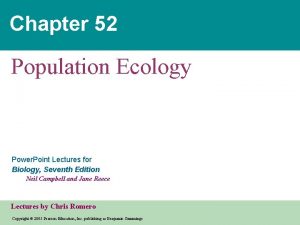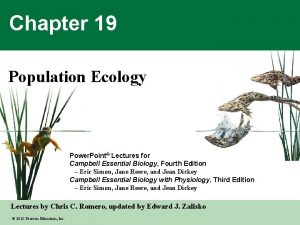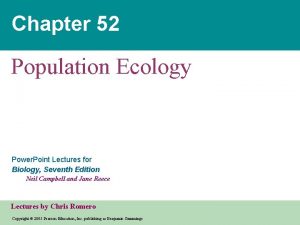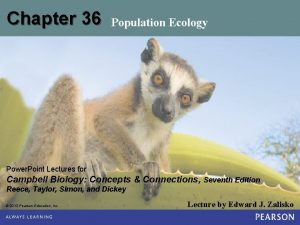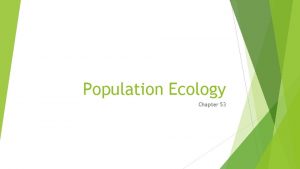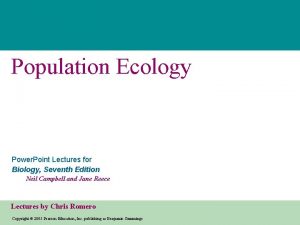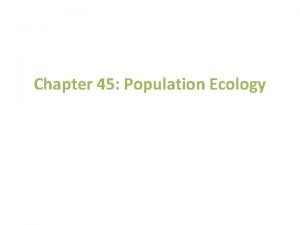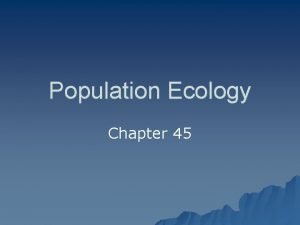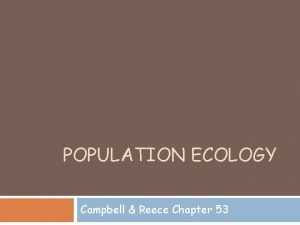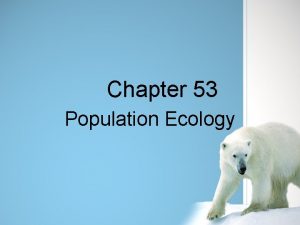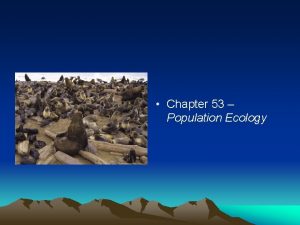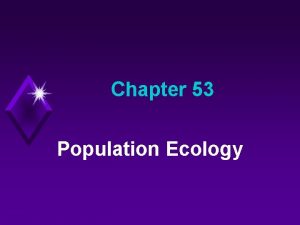Chapter 36 Population Ecology Power Point Lectures for
























































































- Slides: 88

Chapter 36 Population Ecology Power. Point Lectures for Campbell Biology: Concepts & Connections, Seventh Edition Reece, Taylor, Simon, and Dickey © 2012 Pearson Education, Inc. Lecture by Edward J. Zalisko

Introduction § Individual emperor penguins face the rigors of the Antarctic climate and have special adaptations, including a – downy underlayer of feathers for insulation and – thick layer of fat for energy storage and insulation. § The entire population of emperor penguins reflects group characteristics, including the – survivorship of chicks and – growth rate of the population. © 2012 Pearson Education, Inc.

Introduction § Population ecologists study natural population – structure and – dynamics. © 2012 Pearson Education, Inc.

Figure 36. 0_1 Chapter 36: Big Ideas 1985 Male Population Structure and Dynamics Female The Human Population

Figure 36. 0_2

POPULATION STRUCTURE AND DYNAMICS © 2012 Pearson Education, Inc.

36. 1 Population ecology is the study of how and why populations change § A population is a group of individuals of a single species that occupy the same general area. § Individuals in a population – rely on the same resources, – are influenced by the same environmental factors, and – are likely to interact and breed with one another. © 2012 Pearson Education, Inc.

36. 1 Population ecology is the study of how and why populations change § A population can be described by the number and distribution of individuals. § Population dynamics, the interactions between biotic and abiotic factors, cause variations in population sizes. © 2012 Pearson Education, Inc.

36. 1 Population ecology is the study of how and why populations change § Population ecology is concerned with – the changes in population size and – factors that regulate populations over time. § Populations – increase through birth and immigration to an area and – decrease through death and emigration out of an area. © 2012 Pearson Education, Inc.

36. 2 Density and dispersion patterns are important population variables § Population density is the number of individuals of a species per unit area or volume. § Examples of population density include the – number of oak trees per square kilometer in a forest or – number of earthworms per cubic meter in forest soil. § Ecologists use a variety of sampling techniques to estimate population densities. © 2012 Pearson Education, Inc.

36. 2 Density and dispersion patterns are important population variables § Within a population’s geographic range, local densities may vary greatly. § The dispersion pattern of a population refers to the way individuals are spaced within their area. Video: Flapping Geese (clumped) Video: Albatross Courtship (uniform) Video: Prokaryotic Flagella (Salmonella typhimurium) (random) © 2012 Pearson Education, Inc.

36. 2 Density and dispersion patterns are important population variables § Dispersion patterns can be clumped, uniform, or random. – In a clumped pattern – resources are often unequally distributed and – individuals are grouped in patches. © 2012 Pearson Education, Inc.

Figure 36. 2 A

Figure 36. 2 A_1

36. 2 Density and dispersion patterns are important population variables § In a uniform pattern, individuals are – most likely interacting and – equally spaced in the environment. © 2012 Pearson Education, Inc.

Figure 36. 2 B

Figure 36. 2 B_1

36. 2 Density and dispersion patterns are important population variables § In a random pattern of dispersion, the individuals in a population are spaced in an unpredictable way. © 2012 Pearson Education, Inc.

Figure 36. 2 C

Figure 36. 2 C_1

36. 3 Life tables track survivorship in populations § Life tables track survivorship, the chance of an individual in a given population surviving to various ages. § Survivorship curves plot survivorship as the proportion of individuals from an initial population that are alive at each age. § There are three main types of survivorship curves. – Type III © 2012 Pearson Education, Inc.

Table 36. 3

Percentage of survivors (log scale) Figure 36. 3 100 I 10 II 1 III 0. 1 0 50 Percentage of maximum life span 100

36. 4 Idealized models predict patterns of population growth § The rate of population increase under ideal conditions is called exponential growth. It can be calculated using the exponential growth model equation, G = r. N, in which – G is the growth rate of the population, – N is the population size, and – r is the per capita rate of increase (the average contribution of each individual to population growth). § Eventually, one or more limiting factors will restrict population growth. © 2012 Pearson Education, Inc.

Population size (N) Figure 36. 4 A 500 450 400 350 300 250 200 150 100 50 0 0 1 2 3 4 5 6 7 8 9 10 11 12 Time (months)

Figure 36. 4 A_1 Population size (N) 500 450 400 350 300 250 200 150 100 50 0 1 2 3 4 5 6 7 8 9 10 11 12 Time (months)

Figure 36. 4 A_2

Table 36. 4 A

36. 4 Idealized models predict patterns of population growth § The logistic growth model is a description of idealized population growth that is slowed by limiting factors as the population size increases. § To model logistic growth, the formula for exponential growth, r. N, is multiplied by an expression that describes the effect of limiting factors on an increasing population size. § K stands for carrying capacity, the maximum population size a particular environment can sustain. © 2012 Pearson Education, Inc.

Breeding male fur seals (thousands) Figure 36. 4 B 10 8 6 4 2 0 1915 1925 1935 Year 1945

Breeding male fur seals (thousands) Figure 36. 4 B_1 10 8 6 4 2 0 1915 1925 1935 Year 1945

Figure 36. 4 B_2

Number of individuals (N) Figure 36. 4 C G r. N K 0 G Time (K N) r. N K

Table 36. 4 B

36. 5 Multiple factors may limit population growth § The logistic growth model predicts that population growth will slow and eventually stop as population density increases. § At increasing population densities, densitydependent rates result in – declining births and – increases in deaths. © 2012 Pearson Education, Inc.

Figure 36. 5 A Average clutch size 12 11 10 9 8 0 10 20 30 40 50 60 70 80 Number of breeding pairs 90

36. 5 Multiple factors may limit population growth § Intraspecific competition is – competition between individuals of the same species for limited resources and – is a density-dependent factor that limits growth in natural populations. © 2012 Pearson Education, Inc.

36. 5 Multiple factors may limit population growth § Limiting factors may include – food, – nutrients, – retreats for safety, or – nesting sites. © 2012 Pearson Education, Inc.

Figure 36. 5 B 100 Survivors (%) 80 60 40 20 40 60 80 100 120 Density (beetles/0. 5 g flour)

36. 5 Multiple factors may limit population growth § In many natural populations, abiotic factors such as weather may affect population size well before density-dependent factors become important. § Density-independent factors are unrelated to population density. These may include – fires, – storms, – habitat destruction by human activity, or – seasonal changes in weather (for example, in aphids). © 2012 Pearson Education, Inc.

Number of aphids Figure 36. 5 C Exponential growth Apr May Jun Sudden decline Jul Aug Sep Oct Nov Dec Month

36. 6 Some populations have “boom-and-bust” cycles § Some populations fluctuate in density with regularity. § Boom-and-bust cycles may be due to – food shortages or – predator-prey interactions. © 2012 Pearson Education, Inc.

160 Snowshoe hare 120 9 Lynx 80 6 40 3 0 0 1850 1875 Year 1900 1925 Lynx population size (thousands) Hare population size (thousands) Figure 36. 6

160 Snowshoe hare 120 9 Lynx 80 6 40 3 0 0 1850 1875 Year 1900 1925 Lynx population size (thousands) Hare population size (thousands) Figure 36. 6_1

Figure 36. 6_2

36. 7 EVOLUTION CONNECTION: Evolution shapes life histories § The traits that affect an organism’s schedule of reproduction and death make up its life history. § Key life history traits include – age of first reproduction, – frequency of reproduction, – number of offspring, and – amount of parental care. © 2012 Pearson Education, Inc.

36. 7 EVOLUTION CONNECTION: Evolution shapes life histories § Populations with so-called r-selected life history traits – produce more offspring and – grow rapidly in unpredictable environments. § Populations with K-selected traits – raise fewer offspring and – maintain relatively stable populations. § Most species fall between these two extremes. © 2012 Pearson Education, Inc.

36. 7 EVOLUTION CONNECTION: Evolution shapes life histories § A long-term project in Trinidad – studied guppy populations, – provided direct evidence that life history traits can be shaped by natural selection, and – demonstrated that questions about evolution can be tested by field experiments. © 2012 Pearson Education, Inc.

Guppies: Larger at sexual maturity Experiment: Transplant guppies Results Pool 3 Pools with killifish but no guppies prior to transplant Pool 2 Predator: Pikecichlid; preys on large guppies Guppies: Smaller at sexual maturity Hypothesis: Predator feeding preferences caused difference in life history traits of guppy populations. Mass of guppies at maturity (mg) Pool 1 Predator: Killifish; preys on small guppies 185. 6 200 161. 5 160 120 80 67. 5 76. 1 40 Age of guppies at maturity (days) Figure 36. 7 100 85. 7 92. 3 80 60 48. 5 58. 2 40 20 Males Females Control: Guppies from pools with pike-cichlids as predators Experimental: Guppies transplanted to pools with killifish as predators

Figure 36. 7_s 1 Pool 1 Predator: Killifish; preys on small guppies Guppies: Larger at sexual maturity

Figure 36. 7_s 2 Pool 1 Predator: Killifish; preys on small guppies Guppies: Larger at sexual maturity Pool 2 Predator: Pikecichlid; preys on large guppies Guppies: Smaller at sexual maturity Hypothesis: Predator feeding preferences caused difference in life history traits of guppy populations.

Figure 36. 7_s 3 Pool 1 Predator: Killifish; preys on small guppies Guppies: Larger at sexual maturity Experiment: Transplant guppies Pool 3 Pools with killifish but no guppies prior to transplant Pool 2 Predator: Pikecichlid; preys on large guppies Guppies: Smaller at sexual maturity Hypothesis: Predator feeding preferences caused difference in life history traits of guppy populations.

200 160 120 80 40 185. 6 161. 5 67. 5 76. 1 Males Females Control: Guppies from pools with pike-cichlids as predators Age of guppies at maturity (days) Mass of guppies at maturity (mg) Figure 36. 7_2 100 80 60 40 20 85. 7 92. 3 48. 5 58. 2 Males Females Experimental: Guppies transplanted to pools with killifish as predators

36. 8 CONNECTION: Principles of population ecology have practical applications § Sustainable resource management involves – harvesting crops and – eliminating damage to the resource. § The cod fishery off Newfoundland – was overfished, – collapsed in 1992, and – still has not recovered. § Resource managers use population ecology to determine sustainable yields. © 2012 Pearson Education, Inc.

Yield (thousands of metric tons) Figure 36. 8 900 800 700 600 500 400 300 200 100 0 1960 1970 1980 1990 2000

THE HUMAN POPULATION © 2012 Pearson Education, Inc.

36. 9 The human population continues to increase, but the growth rate is slowing § The human population – grew rapidly during the 20 th century and – currently stands at about 7 billion. © 2012 Pearson Education, Inc.

100 80 10 Population increase 8 60 6 40 4 Total population size 20 1500 1550 1600 1650 1700 1750 1800 1850 1900 1950 2000 2050 Year 2 0 Total population (in billions) Annual increase (in millions) Figure 36. 9 A

36. 9 The human population continues to increase, but the growth rate is slowing § The demographic transition – is the shift from high birth and death rates – to low birth and death rates, and – has lowered the rate of growth in developed countries. © 2012 Pearson Education, Inc.

Figure 36. 9 B Birth or death rate per 1, 000 population 50 40 30 Rate of increase 20 10 Birth rate Death rate 0 1900 1925 1950 1975 2000 2025 2050 Year

36. 9 The human population continues to increase, but the growth rate is slowing § In the developing nations – death rates have dropped, – birth rates are still high, and – these populations are growing rapidly. © 2012 Pearson Education, Inc.

Table 36. 9

36. 9 The human population continues to increase, but the growth rate is slowing § The age structure of a population – is the proportion of individuals in different age groups and – affects the future growth of the population. © 2012 Pearson Education, Inc.

36. 9 The human population continues to increase, but the growth rate is slowing § Population momentum is the continued growth that occurs – despite reduced fertility and – as a result of girls in the 0– 14 age group of a previously expanding population reaching their childbearing years. © 2012 Pearson Education, Inc.

Age Figure 36. 9 C 80 75– 79 70– 74 65– 69 60– 64 55– 59 50– 54 45– 49 40– 44 35– 39 30– 34 25– 29 20– 24 15– 19 10– 14 5– 9 0– 4 1985 Male 6 5 4 2010 Female 3 2 1 0 1 2 3 4 5 6 Population in millions Total population size 76, 767, 225 Male 2035 Female 5 4 3 2 1 0 1 2 3 4 5 Estimated population in millions Total population size 112, 468, 855 Male Female 5 4 3 2 1 0 1 2 3 4 5 Projected population in millions Total population size 139, 457, 070

Age Figure 36. 9 C_1 80 75– 79 70– 74 65– 69 60– 64 55– 59 50– 54 45– 49 40– 44 35– 39 30– 34 25– 29 20– 24 15– 19 10– 14 5– 9 0– 4 1985 Male Female 6 5 4 3 2 1 0 1 2 3 4 5 6 Population in millions Total population size 76, 767, 225

Age Figure 36. 9 C_2 80 75– 79 70– 74 65– 69 60– 64 55– 59 50– 54 45– 49 40– 44 35– 39 30– 34 25– 29 20– 24 15– 19 10– 14 5– 9 0– 4 2010 Male Female 5 4 3 2 1 0 1 2 3 4 5 Estimated population in millions Total population size 112, 468, 855

Age Figure 36. 9 C_3 80 75– 79 70– 74 65– 69 60– 64 55– 59 50– 54 45– 49 40– 44 35– 39 30– 34 25– 29 20– 24 15– 19 10– 14 5– 9 0– 4 2035 Male Female 5 4 3 2 1 0 1 2 3 4 5 Projected population in millions Total population size 139, 457, 070

36. 10 CONNECTION: Age structures reveal social and economic trends § Age-structure diagrams reveal – a population’s growth trends and – social conditions. © 2012 Pearson Education, Inc.

Figure 36. 10 Age Birth years 85 80– 84 75– 79 70– 74 65– 69 60– 64 55– 59 50– 54 45– 49 40– 44 35– 39 30– 34 25– 29 20– 24 15– 19 10– 14 5– 9 0– 4 1985 Male Female before 1901– 1905 1906– 10 1911– 15 1916– 20 1921– 25 1926– 30 1931– 35 1936– 40 1941– 45 1946– 50 1951– 55 1956– 60 1961– 65 1966– 70 1971– 75 1976– 80 1981– 85 Birth years 2010 Male Female before 1926– 30 1931– 35 1936– 40 1941– 45 1946– 50 1951– 55 1956– 60 1961– 65 1966– 70 1971– 75 1976– 80 1981– 85 1986– 90 1991– 95 1996– 2000 2001– 2005 2006– 2010 12 10 8 6 4 2 0 2 4 6 8 10 12 Population in millions Total population size 238, 466, 283 Birth years 2035 Male Female before 1951– 55 1956– 60 1961– 65 1966– 70 1971– 75 1976– 80 1981– 85 1986– 90 1991– 95 1996– 2000 2001– 05 2006– 10 2011– 15 2016– 20 2021– 25 2026– 30 2031– 35 12 10 8 6 4 2 0 2 4 6 8 10 12 Estimated population in millions Total population size 310, 232, 863 12 10 8 6 4 2 0 2 4 6 8 10 12 Projected population in millions Total population size 389, 531, 156

Figure 36. 10_1 Age Birth years 1985 Male Female before 1901 85 80– 84 1901– 1905 75– 79 1906– 10 1911– 15 70– 74 1916– 20 65– 69 1921– 25 60– 64 1926– 30 55– 59 1931– 35 50– 54 1936– 40 45– 49 1941– 45 40– 44 1946– 50 35– 39 30– 34 1951– 55 25– 29 1956– 60 20– 24 1961– 65 15– 19 1966– 70 10– 14 1971– 75 1976– 80 5– 9 1981– 85 0– 4 12 10 8 6 4 2 0 2 4 6 8 10 12 Population in millions Total population size 238, 466, 283

Figure 36. 10_2 Age Birth years 85 80– 84 75– 79 70– 74 65– 69 60– 64 55– 59 50– 54 45– 49 40– 44 35– 39 30– 34 25– 29 20– 24 15– 19 10– 14 5– 9 0– 4 2010 Male Female before 1926– 30 1931– 35 1936– 40 1941– 45 1946– 50 1951– 55 1956– 60 1961– 65 1966– 70 1971– 75 1976– 80 1981– 85 1986– 90 1991– 95 1996– 2000 2001– 2005 2006– 2010 12 10 8 6 4 2 0 2 4 6 8 10 12 Estimated population in millions Total population size 310, 232, 863

Figure 36. 10_3 Age Birth years 2035 Male Female before 1951 85 80– 84 1951– 55 75– 79 1956– 60 70– 74 1961– 65 1966– 70 65– 69 1971– 75 60– 64 1976– 80 55– 59 1981– 85 50– 54 1986– 90 45– 49 40– 44 1991– 95 35– 39 1996– 2000 30– 34 2001– 05 25– 29 2006– 10 20– 24 2011– 15 15– 19 2016– 20 10– 14 2021– 25 5– 9 2026– 30 0– 4 2031– 35 12 10 8 6 4 2 0 2 4 6 8 10 12 Projected population in millions Total population size 389, 531, 156

36. 11 CONNECTION: An ecological footprint is a measure of resource consumption § The U. S. Census Bureau projects a global population of – 8 billion people within the next 20 years and – 9. 5 billion by mid-21 st century. § Do we have sufficient resources to sustain 8 or 9 billion people? § To accommodate all the people expected to live on our planet by 2025, the world will have to double food production. © 2012 Pearson Education, Inc.

36. 11 CONNECTION: An ecological footprint is a measure of resource consumption § An ecological footprint is an estimate of the amount of land required to provide the raw materials an individual or a nation consumes, including – food, – fuel, – water, – housing, and – waste disposal. © 2012 Pearson Education, Inc.

36. 11 CONNECTION: An ecological footprint is a measure of resource consumption § The United States – has a very large ecological footprint, much greater than its own land, and – is running on a large ecological deficit. § Some researchers estimate that – if everyone on Earth had the same standard of living as people living in the United States, – we would need the resources of 4. 5 planet Earths. © 2012 Pearson Education, Inc.

Figure 36. 11 A

Figure 36. 11 A_1

Figure 36. 11 A_2

Figure 36. 11 B Ecological Footprints (gha per capita) 0– 1. 5– 3. 0– 4. 5– 6. 0– 7. 5– 9. 0– 10. 5 Insufficient data

You should now be able to 1. Define a population and population ecology. 2. Define population density and describe different types of dispersion patterns. 3. Explain how life tables are used to track mortality and survivorship in populations. 4. Compare Type I, Type II, and Type III survivorship curves. 5. Describe and compare the exponential and logistic population growth models, illustrating both with examples. © 2012 Pearson Education, Inc.

You should now be able to 6. Explain the concept of carrying capacity. 7. Describe the factors that regulate growth in natural populations. 8. Define boom-and-bust cycles, explain why they occur, and provide examples. 9. Explain how life history traits vary with environmental conditions and with population density. 10. Compare r-selection and K-selection and indicate examples of each. © 2012 Pearson Education, Inc.

You should now be able to 11. Describe the major challenges inherent in managing populations. 12. Explain how the structure of the world’s human population has changed and continues to change. 13. Explain how the age structure of a population can be used to predict changes in population size and social conditions. 14. Explain the concept of an ecological footprint. Describe the uneven use of natural resources in the world. © 2012 Pearson Education, Inc.

Percentage of survivors Figure 36. UN 01 Few large offspring, low mortality I until old age II Many small offspring, high mortality III Percentage of maximum life span

Age Figure 36. UN 02 80 75– 79 70– 74 65– 69 60– 64 55– 59 50– 54 45– 49 40– 44 35– 39 30– 34 25– 29 20– 24 15– 19 10– 14 5– 9 0– 4 2010 1985 Male Female 6 5 4 3 2 1 0 1 2 3 4 5 Population in millions Total population size 76, 767, 225 Population in millions Total population size 112, 468, 855

Figure 36. UN 03 (K N) G r. N K

Figure 36. UN 04 II Birth or death rate I Time III IV

Figure 36. UN 05
 Chapter 4 section 1 population dynamics
Chapter 4 section 1 population dynamics Population ecology section 1 population dynamics answer key
Population ecology section 1 population dynamics answer key Population ecology section 1 population dynamics
Population ecology section 1 population dynamics Population ecology section 1 population dynamics
Population ecology section 1 population dynamics Chapter 53 population ecology
Chapter 53 population ecology Chapter 36 population ecology
Chapter 36 population ecology Ecology
Ecology Chapter 53 population ecology
Chapter 53 population ecology Section 1 population dynamics answer key
Section 1 population dynamics answer key Chapter 53 population ecology
Chapter 53 population ecology Power system lectures
Power system lectures Clumped dispersion
Clumped dispersion Exponential population growth
Exponential population growth Ecology
Ecology Population vs community ecology
Population vs community ecology Concept 3 population ecology
Concept 3 population ecology Population def ecology
Population def ecology Characteristics of population ecology
Characteristics of population ecology Population characteristics
Population characteristics What is population ecology
What is population ecology Population definition ecology
Population definition ecology Population distribution
Population distribution Parasitism pictures
Parasitism pictures Draw the power triangle
Draw the power triangle Power bi training powerpoint
Power bi training powerpoint Point point power
Point point power Rick trebino lectures
Rick trebino lectures Neonatology lectures
Neonatology lectures Data mining lectures
Data mining lectures Medicinal chemistry lectures
Medicinal chemistry lectures Uva ppt template
Uva ppt template Cs614 short lectures
Cs614 short lectures Activity planning in software project management
Activity planning in software project management Cell and molecular biology lectures
Cell and molecular biology lectures Radio astronomy lectures
Radio astronomy lectures Dr sohail lectures
Dr sohail lectures Utilities and energy lectures
Utilities and energy lectures Introduction to web engineering
Introduction to web engineering Do words have power
Do words have power Frcr physics lectures
Frcr physics lectures Frequency of xrays
Frequency of xrays Cs106b lectures
Cs106b lectures Differentiation of rbc
Differentiation of rbc Aerodynamics lectures
Aerodynamics lectures Theory of translation lectures
Theory of translation lectures Theory and practice of translation lectures
Theory and practice of translation lectures Theory of translation lectures
Theory of translation lectures Digital logic design lectures
Digital logic design lectures Kurose ross computer networking
Kurose ross computer networking Hegel three forms of art
Hegel three forms of art Nuclear medicine lectures
Nuclear medicine lectures Gpoint c++
Gpoint c++ Cdeep lectures
Cdeep lectures Oral communication 3 lectures text
Oral communication 3 lectures text C programming and numerical analysis an introduction
C programming and numerical analysis an introduction Haematology lectures
Haematology lectures Bureau of lectures
Bureau of lectures Trend lectures
Trend lectures Theory of translation lectures
Theory of translation lectures Reinforcement learning lectures
Reinforcement learning lectures 13 lectures
13 lectures Reinforcement learning lectures
Reinforcement learning lectures Bba lectures
Bba lectures Medical emergency student lectures
Medical emergency student lectures Hematology medicine student lectures
Hematology medicine student lectures Stratog online lectures
Stratog online lectures Bhadeshia lectures
Bhadeshia lectures Yelena bogdan
Yelena bogdan Comsats virtual campus lectures
Comsats virtual campus lectures Hugh blair lectures on rhetoric
Hugh blair lectures on rhetoric Cern summer student lectures
Cern summer student lectures Pathology lectures for medical students
Pathology lectures for medical students Dr asim lectures
Dr asim lectures Ota core curriculum
Ota core curriculum Anatomy lectures powerpoint
Anatomy lectures powerpoint Cern summer school lectures
Cern summer school lectures Point estimate of population mean
Point estimate of population mean Marine ecology
Marine ecology Chapter 3 section 1: community ecology
Chapter 3 section 1: community ecology Chapter 56 conservation biology and restoration ecology
Chapter 56 conservation biology and restoration ecology Chapter 55 ecosystems and restoration ecology
Chapter 55 ecosystems and restoration ecology Chapter 54: community ecology answer key
Chapter 54: community ecology answer key Chaparral climograph
Chaparral climograph Chapter 5 evolution and community ecology
Chapter 5 evolution and community ecology Chapter 2 principles of ecology
Chapter 2 principles of ecology Principles of ecology chapter 2 section 3 answer key
Principles of ecology chapter 2 section 3 answer key Principles of ecology chapter 2
Principles of ecology chapter 2 More diverse
More diverse Chapter 55 ecosystems and restoration ecology
Chapter 55 ecosystems and restoration ecology





















